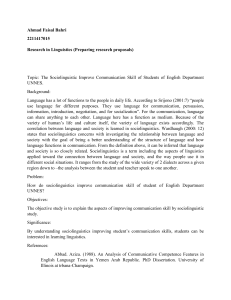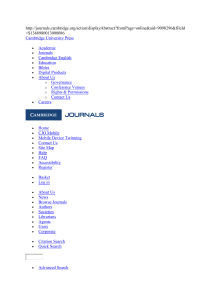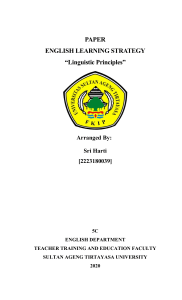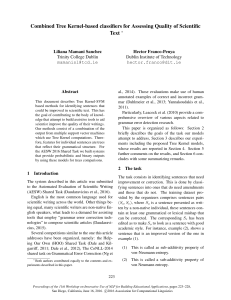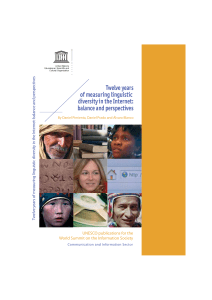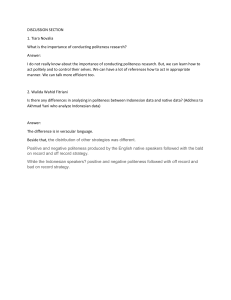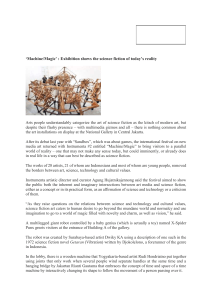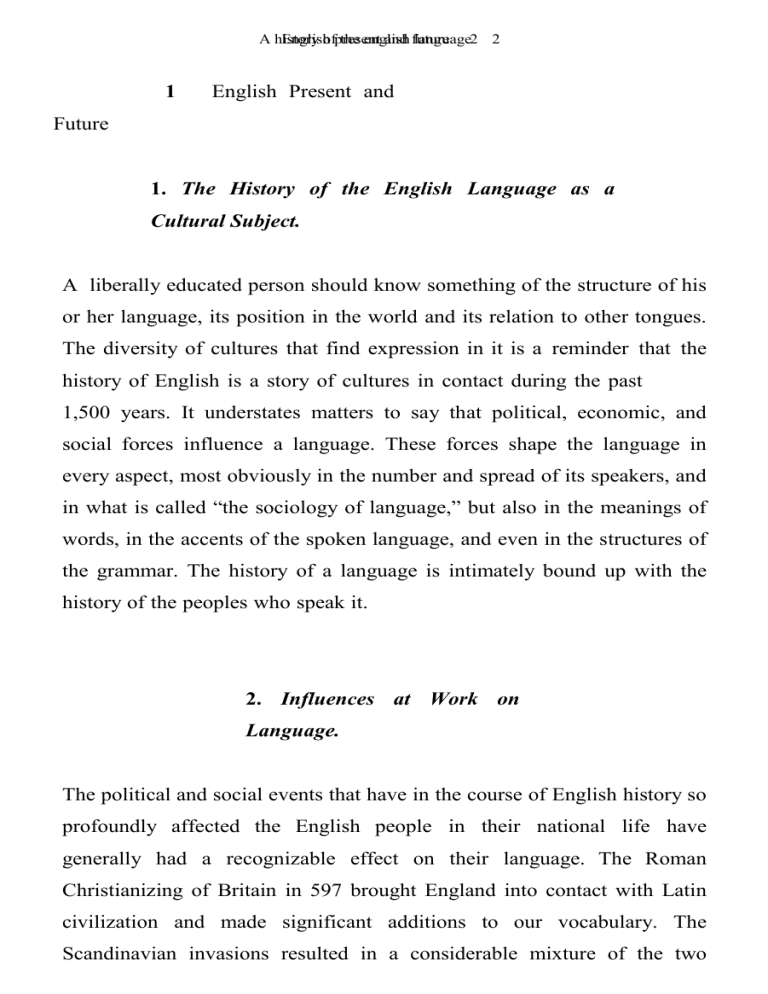
A history Englishofpresent the english and future language2 2 1 English Present and Future 1. The History of the English Language as a Cultural Subject. A liberally educated person should know something of the structure of his or her language, its position in the world and its relation to other tongues. The diversity of cultures that find expression in it is a reminder that the history of English is a story of cultures in contact during the past 1,500 years. It understates matters to say that political, economic, and social forces influence a language. These forces shape the language in every aspect, most obviously in the number and spread of its speakers, and in what is called “the sociology of language,” but also in the meanings of words, in the accents of the spoken language, and even in the structures of the grammar. The history of a language is intimately bound up with the history of the peoples who speak it. 2. Influences at Work on Language. The political and social events that have in the course of English history so profoundly affected the English people in their national life have generally had a recognizable effect on their language. The Roman Christianizing of Britain in 597 brought England into contact with Latin civilization and made significant additions to our vocabulary. The Scandinavian invasions resulted in a considerable mixture of the two A history Englishofpresent the english and future language3 3 peoples and their languages. The Norman Conquest made English for two centuries the language mainly of the lower classes while the nobles and those associated with them used French on almost all occasions. References in scholarly and popular works to “Indian English,” “Caribbean English,” “West African English,” and other regional varieties point to the fact that the political and cultural history of the English language is not simply the history of the British Isles and of North America but a truly international history of quite divergent societies, which have caused the language to change and become enriched as it responds to their own special needs. 3. Growth and Decay. English, like all other languages, is subject to that constant growth and decay that characterize all forms of life. When a language ceases to change, we call it a dead language. Much of the vocabulary of Old English has been lost, and the development of new words to meet new conditions is one of the most familiar phenomena of our language. Change of meaning can be illustrated from any page of Shakespeare. Nice in Shakespeare’s day meant foolish; rheumatism signified a cold in the head. Less familiar but no less real is the change of pronunciation. A slow but steady alteration, especially in the vowel sounds, has characterized English throughout its history. Old English stān has become our stone; cū has become cow. A history Englishofpresent the english and future language4 4 4. The Importance of a Language. A scientific approach to linguistic study combined with a consideration of history reminds us that no language acquires importance because of what are assumed to be purely internal advantages. Languages become important because of events that shape the balance of power among nations. The language of a powerful nation will acquire importance as a direct reflection of political, economic, technological, and military strength; so also will the arts and sciences expressed in that language have advantages, including the opportunities for propagation. English, French, German, and Spanish are important languages because of the history and influence of their populations in modern times; Greek, for example, is studied in its classical form because of the great civilization preserved and recorded in its literature; but in its modern form as spoken in Greece today the Greek language does not serve as a language of wider communication. 5. The Importance of English. In numbers of speakers as well as in its uses for international communication and in other less quantifiable measures, English is one of A history Englishofpresent the english and future language5 5 the most important languages of the world. English, however, is not the most widely used native language in the world. Some of the European languages are comparable to English in reflecting the forces of history, especially with regard to European expansion since the sixteenth century. French and English are both languages of wider communication, and yet the changing positions of the two languages in international affairs during the past century illustrate the extent to which the status of a language depends on extralinguistic factors. But outside the realm of aesthetics, the Ugly Duckling reigns supreme.”1 The ascendancy of English as measured by numbers of speakers in various activities does not depend on nostalgic attitudes toward the originally Englishspeaking people or toward the language itself. Fishman makes the point that English is less loved but more used; French is more loved but less used. And in a world where “econo-technical superiority” is what counts, “the real ‘powerhouse’ is still English. If “econo-technical superiority” is what counts, we might wonder about the relative status of English and Japanese. Although spoken by 125 million people in Japan, a country that has risen to economic and technical dominance since World War II, the Japanese language has yet few of the roles in international affairs that are played by English or French. The reasons are rooted in the histories of these languages. Japan went through a two-century period of isolation from the West (between 1640 and 1854) during which time several European languages were establishing the base of their subsequent expansion. 6. The Future of the English Language. A history Englishofpresent the english and future language6 6 Since growth in a language is primarily a matter of population, the most important question to ask is which populations of the world will A history Englishofpresent the english and future language7 7 increase most rapidly. The single most important fact about current trends is that the Third World countries of Africa, Asia, and Latin America have experienced a sharp drop in mortality during the twentieth century without a corresponding drop in the birth rate. As a result, the population of these areas is younger and growing faster than the population of the industrialized countries of Europe and North America. India is expected to replace China as the world’s most populous nation in half a century, with a concomitant growth in Hindi and Bengali, already among the top five languages in the world. Since most of the native speakers of English live in the developed countries, it can be expected that this group will account for a progressively smaller proportion of the world’s population. If the future of a language were merely a matter of the number who speak it as a first language, English would appear to be entering a period of decline after four centuries of unprecedented expansion. What makes this prospect unlikely is the fact that English is widely used as a second language and as a foreign language throughout the world. In some of the developing countries that are experiencing the greatest growth, English is one of the official languages, as it is in India, Nigeria, and the Philippines. The situation is complex because of widely varying government policies that are subject to change and that often do not reflect the actual facts.Although A history Englishofpresent the english and future language8 8 there are concerted efforts to establish the vernaculars in a number of countries—Hindi in India, Swahili in Tanzania, Tagalog in the Philippines—considerable forces run counter to these efforts and impede the establishment of national languages. The complex interaction of these forces defies general statements of the present situation or specific projections into the distant future. Among European languages it seems likely that English, German, and Spanish will benefit from various developments. The breakup of the Soviet Union and the increasing political and economic unification of Western Europe are already resulting in the shifting fortunes of Russian and German. 7. English as a World Language. That the world is fully alive to the need for an international language is evident from the number of attempts that have been made to supply that need artificially. Between 1880 and 1907 fifty-three universal languages were proposed. Some of these enjoyed an amazing, if temporary, vogue. In 1889 Volapük claimed nearly a million adherents. A few years later Esperanto experienced a similar vogue, but interest in it now is kept alive largely by local groups and organizations. Apparently the need has not been filled by any of the laboratory products so far created to fill it. And it is doubtful if it ever can be filled in this way. Recent history has shown language policy continuing to be a highly emotional issue, the language of a country often symbolizing its independence and nationalism. A history Englishofpresent the english and future language9 9 The emotions that militate against the establishment of an artificial language work even more strongly against the establishment of a single foreign language for international communication. It will be the combined effect of economic and cultural forces such as these, rather than explicit legislation by national or international bodies, that will determine the world languages of the future. As the colonies gained independence, English continued to be used alongside the vernaculars. In many of the new countries English is either the primary language or a necessary second language in the schools, the courts, and business. Braj B.Kachru: One reason for this dominance of English is its propensity for acquiring new identities, its power of assimilation, its adaptability for ‘decolonization’ as a language, its manifestation in a range of varieties, and above all its suitability as a flexible medium for literary and other types of creativity across languages and cultures.” A history Englishofpresent the english and future language10 10 The world is poorer when a language dies on average every two weeks. For native speakers of English as well, the status of the English language can be a mixed blessing, especially if the great majority of English speakers remain monolingual. Online shoppers around the world prefer to use the Internet in their own language and that English-language sites in the United States have lost market share to local sites in other countries. Liabilities. . Depending on many variables in the background of the learner, some of these features may facilitate the learning of English, and others may make the effort more difficult. Among the many variables in the difficulty of learning a language as an adult, perhaps the most important is the closeness of the speaker’s native language to the language that is being learned. Linguists are far from certain how to measure complexity in a language. Even after individual features have been recognized as relatively easy or difficult to learn, the weighting of these features within a single language varies according to the theoretical framework assumed. In a modern theory A history Englishofpresent the english and future language11 11 9. Cosmopolitan Vocabulary. English is classified as a Germanic language. That is to say, it belongs to the group of languages to which German, Dutch, Flemish, Danish, Swedish, and Norwegian also belong. On the other hand, more than half of its vocabulary is derived from Latin. English presents a somewhat familiar appearance to anyone who speaks either a Germanic or a Romance language. Instead of making new words chiefly by the combination of existing elements, as German does, English has shown a marked tendency to go outside its own linguistic resources and borrow from other languages. In the course of centuries of this practice English has built up an unusual capacity for assimilating outside elements (raccon, Native American/ landscape, Dutch/ balcony, Italian/ mosquito, Spanish/ catastrophe, Greek/Vodka, Russian/ dervish, Persian). English has assimilated these heterogeneous elements so successfully that only the professional student of language is aware of their origin. Despite problems with faux amis—those words that have different meanings in two different languages—cognates generally are learned more rapidly and retained longer than words that are unrelated to A history Englishofpresent the english and future language12 12 words in the native language lexicon.8 The cosmopolitan vocabulary of English with its cognates in many languages is an undoubted asset. 10. Inflectional Simplicity. A second feature that English possesses to a preeminent degree is inflectional simplicity. In this process of simplifying inflections English has gone further than any other language in Europe. It must not be thought that these developments represent a decay of grammar on the one hand or a Darwinian evolution toward progress, simplicity, and efficiency on the other. 11. Natural Gender. English differs from all other major European languages in having adopted natural (rather than grammatical) gender. A history Englishofpresent the english and future language13 13 In the English language all this was stripped away during the Middle English period, and today the gender of every noun in the dictionary is known instantly. Gender in English is determined by meaning. All nouns naming living creatures are masculine or feminine according to the sex of the individual, and all other nouns are neuter. 12. Liabilities. One of these difficulties is the result of that very simplification of inflections which we have considered among the assets of English. It is the difficulty, of which foreigners often complain, of expressing themselves not only logically, but also idiomatically: the German says was für ein Mann (what for a man) whereas in English we say what kind of man; the French say il fait froid (it makes cold) whereas we say it is cold. A more serious criticism of English by those attempting to master it is the chaotic character of its spelling and the frequent lack of correlation between spelling and pronunciation. The situation is even more confusing in A history Englishofpresent the english and future language14 14 our treatment of the consonants. We have a dozen spellings for the sound of sh: shoe, sugar, issue, nation, suspicion, ocean, nauseous, conscious, chaperon, schist, fuchsia, pshaw. There are those who emphasize the useful way in which the spelling of an English word often indicates its etymology. It has been further suggested that the very looseness of our orthography makes less noticeable in the written language the dialectal differences that would be revealed if the various parts of the English-speaking world attempted a more phonetic notation on the basis of their local pronunciation. It remains to be seen whether the extension of English in the future will some day compel us to consider the reform of our spelling from an impersonal and, indeed, international point of view. BIBLIOGRAP HY An influential introduction to the study of language, and still valuable, is Leonard Bloomfield, Language (New York, 1933). Classic works by other founders of modern linguistics are Edward Sapir, Language: An Introduction to the Study of Speech (New York, 1921); Otto Jespersen, Language, Its Nature, Development and Origin (New York, 1922); and Ferdinand de Saussure, Cours de linguistique générale (Course in General Linguistics), ed. C.Bally et al., trans. Wade Baskin (New York, 1959). Among the many general works that incorporate recent linguistic advances, see especially Victoria A.Fromkin and Robert Rodman, An A history Englishofpresent the english and future language15 15 Introduction to Language (6th ed., New York, 1998). Of great historical importance and permanent value is Hermann A history Englishofpresent the english and future language16 16 Paul’s Principien der Sprachgeschichte, trans. H.A.Strong under the title Principles of the History of Language (rev. ed., London, 1891). Introductions to historical linguistics include Winfred Lehmann, Historical Linguistics: An Introduction (3rd ed., New York, 1992); Raimo Anttila, An Introduction to Historical and Comparative Linguistics (2nd ed., Amsterdam, 1989); Hans Henrich Hock and Brian D.Joseph, Language History, Language Change, and Language Relationship: An Introduction to Historical and Comparative Linguistics (Berlin, 1996); and Lyle Campbell, Historical Linguistics: An Introduction (Cambridge, MA, 1999). For applications of linguistic theory to traditional diachronic issues, see Robert D.King, Historical Linguistics and Generative Grammar (Englewood Cliffs, NJ, 1969); Elizabeth C.Traugott, A History of English Syntax (New York, 1972); David Lightfoot, Principles of Diachronic Syntax (Cambridge, UK, 1979) and his How to Set Parameters: Arguments from Language Change (Cambridge, MA, 1991). Sociolinguistic applications to historical problems figure prominently in Suzanne Romaine, Sociohistorical Linguistics: Its Status and Methodology (Cambridge, UK, 1982); Jean Aitchison, Language Change: Progress or Decay? (2nd ed., Cambridge, UK, 1991); James Milroy, Linguistic Variation and Change: On the Historical Sociolinguistics of English (Oxford, 1992); and Tim William Machan and Charles T.Scott, eds., English in Its Social Contexts: Essays in Historical Sociolinguistics (New York, 1992). The advanced student may consult Henry M.Hoenigswald, Language Change and Linguistic Reconstruction (Chicago, A history Englishofpresent the english and future language17 17 1960); Hans Henrich Hock’s Principles of Historical Linguistics (2nd ed., Berlin, 1991); and Roger Lass, Historical Linguistics and Language Change (Cambridge, UK, 1997). A clear overview of how grammatical forms arise from lexical items is by Paul J.Hopper and Elizabeth Closs Traugott, Grammaticalization (Cambridge, UK, 1993). H.Pedersen’s Linguistic Science in the Nineteenth Century, trans. John W.Spargo (Cambridge, MA, 1931; reprinted as The Discovery of Language, 1962) gives an illuminating account of the growth of comparative philology; a briefer record will be found in Book I of Jespersen’s Language. A concise history of linguistic study is R.H.Robins, A Short History of Linguistics (3rd ed., London, 1990), and a generally excellent survey of both the study and substance of linguistics is Frederick J.Newmeyer, ed., Linguistics: The Cambridge Survey (4 vols., Cambridge, UK, 1988). Statistics on the number of people speaking the languages of the world may be found in Ethnologue: Languages of the World, ed. Barbara F.Grimes (14th ed., 2 vols., Dallas, 2000), and at the website, www.sil.org/ethnologue. Since the spread of English is largely a matter of population, the question of population growth is of importance. For current statistics and bibliography, see the quarterly journal Population Index (Office of Population Research, Princeton) and Statistical Yearbook and Demographic Yearbook, both published by the United Nations. On the cosmopolitan character of the English vocabulary, see Mary S.Serjeantson, A History of Foreign Words in English (London, 1935). Two valuable reference works for the English language are Tom McArthur, ed., The Oxford A history Englishofpresent the english and future language18 18 Companion to the English Language (Oxford, 1992) and David Crystal, The Cambridge Encyclopedia of the English Language (Cambridge, UK, 1995). English as a world language has received perhaps more scholarly and popular attention during the past three decades than any other topic. A readable introduction is by David Crystal, English as a Global Language (Cambridge, UK, 1997), who has also written on endangered languages in Language Death (Cambridge, UK, 2000). Implications and points of view are summarized by Tom McArthur, The English Languages (Cambridge, UK, 1998) and presented in essays in World Englishes 2000, ed. Larry E. Smith and Michael L.Forman (Honolulu, 1997). For detailed descriptions of the worldwide varieties, see the essays in the following collections: Richard W.Bailey and Manfred Görlach, eds. English as a World Language (Ann Arbor, MI, 1982); John B.Pride, ed., New Englishes (Rowley, MA, 1982); John Platt, H.Weber, and H.M. Lian, The New Englishes (London, 1984); Braj B.Kachru, ed., The Other Tongue: English across Cultures (2nd ed., Urbana, IL, 1992); and Edgar W.Schneider, ed., Englishes around the World (2 vols., Amsterdam, 1997). Three periodicals treat the subject: English WorldWide, English Today, and A history Englishofpresent the english and future language19 19 World Englishes. For additional studies of national and areal varieties and on pidgins and creoles, see the references in Chapter 10. For a historical overview of the tradition of English language study, see Helmut Gneuss, Die Wissenschaft von der englischen Sprache: Ihre Entwicklung bis zum Ausgang des 19 Jahrhunderts (Munich, 1990). Among the better known older histories of English the following may be listed: G.P.Marsh, Lectures on the English Language (1860; rev. ed., New York, 1885), and The Origin and History of the English Language (1862; rev. ed., New York, 1885); T.R.Lounsbury, A History of the English Language (2nd ed., New York, 1894); O.F.Emerson, The History of the English Language (New York, 1894); Henry Bradley, The Making of English (1904; rev. Bergen Evans and Simeon Potter, New York, 1967); Otto Jespersen, Growth and Structure of the English Language (1905; 10th ed., Oxford, 1982); H.C.Wyld, The Historical Study of the Mother Tongue (New York, 1906), and A Short History of English (1914; 3rd ed., London, 1927); G.P.Krapp, Modern English, Its Growth and Present Use (1909; rev. A.H.Marckwardt, New York, 1969); René Huchon, Histoire de la langue anglaise (2 vols., Paris, 1923–1930); and G.H.McKnight, Modern English in the Making (New York, 1928; reprinted as The Evolution of the English Language, 1968). Among the numerous later titles, which may readily be found in bibliographies and publishers’ catalogues, note especially Barbara M.J.Strang, A History of English (London, 1970); Thomas Pyles and John Algeo, The Origins and A history Englishofpresent the english and future language20 20 Development of the English Language (4th ed., New York, 1993); and C.M.Millward, A Biography of the English Language (2nd ed., New York, 1996). A six-volume Cambridge History of the English Language, edited by Richard Hogg (Cambridge, UK, 1992–) is now complete except for the final volume. The history of English syntax receives its most impressive documentation in F.T.Visser, An Historical Syntax of the English Language (3 vols., Leiden, Netherlands, 1963– 1973). Such compendiums of data are now increasingly computerized, as in the ambitious project at the University of Helsinki described in essays edited by M.Rissanen, M.Kytö, and M.Palander-Collin, Early English in the Computer Age: Explorations through the Helsinki Corpus (Berlin, 1993). For all references prior to 1923, the student should consult the invaluable Bibliography of Writings on the English Language by Arthur G.Kennedy (Cambridge and New Haven, 1927) supplemented by R.C.Alston, A Bibliography of the English Language…to the Year 1800 (Leeds, UK, 1965–1987). The most complete record of current publications is the Bibliographie linguistique des années 1939–1947 (2 vols., Utrecht-Brussels, 1949–1950) and its annual supplements, published with the support of UNESCO. See also the annual bibliography of the Modern Language Association (vol. 3, Linguistics) and Jacek Fisiak’s selective and convenient Bibliography of Writings for the History of the English Language (2nd ed., Berlin, 1987).

